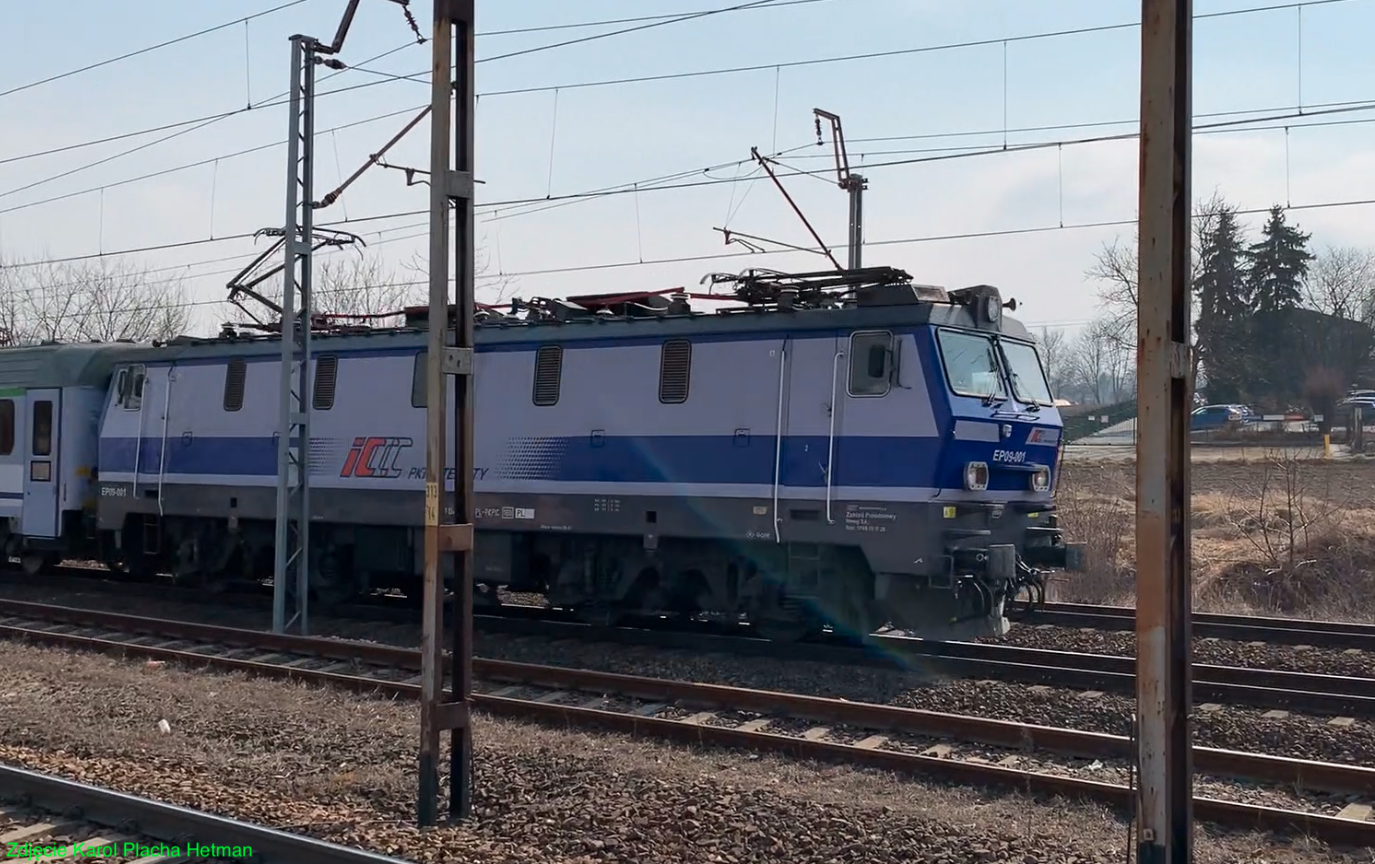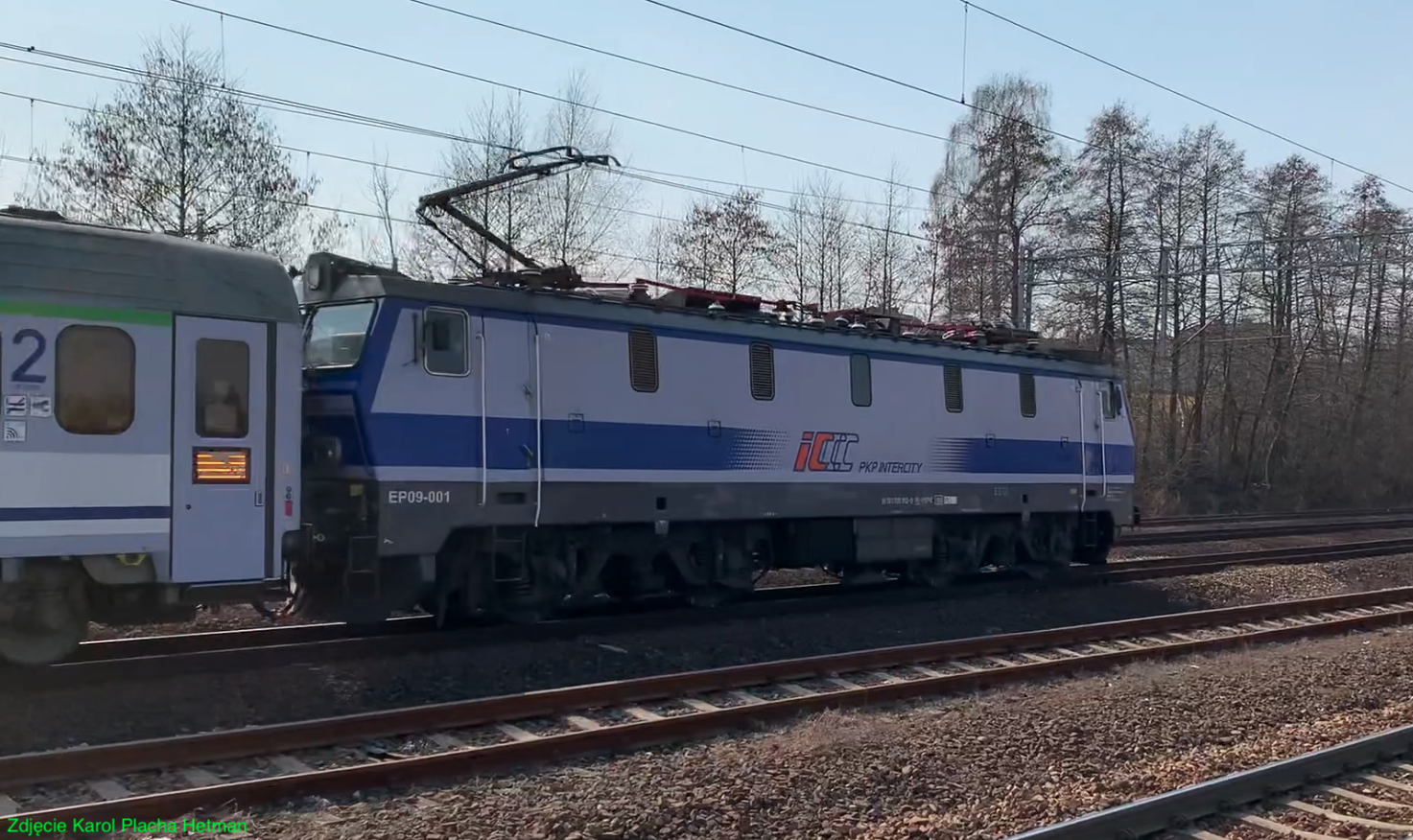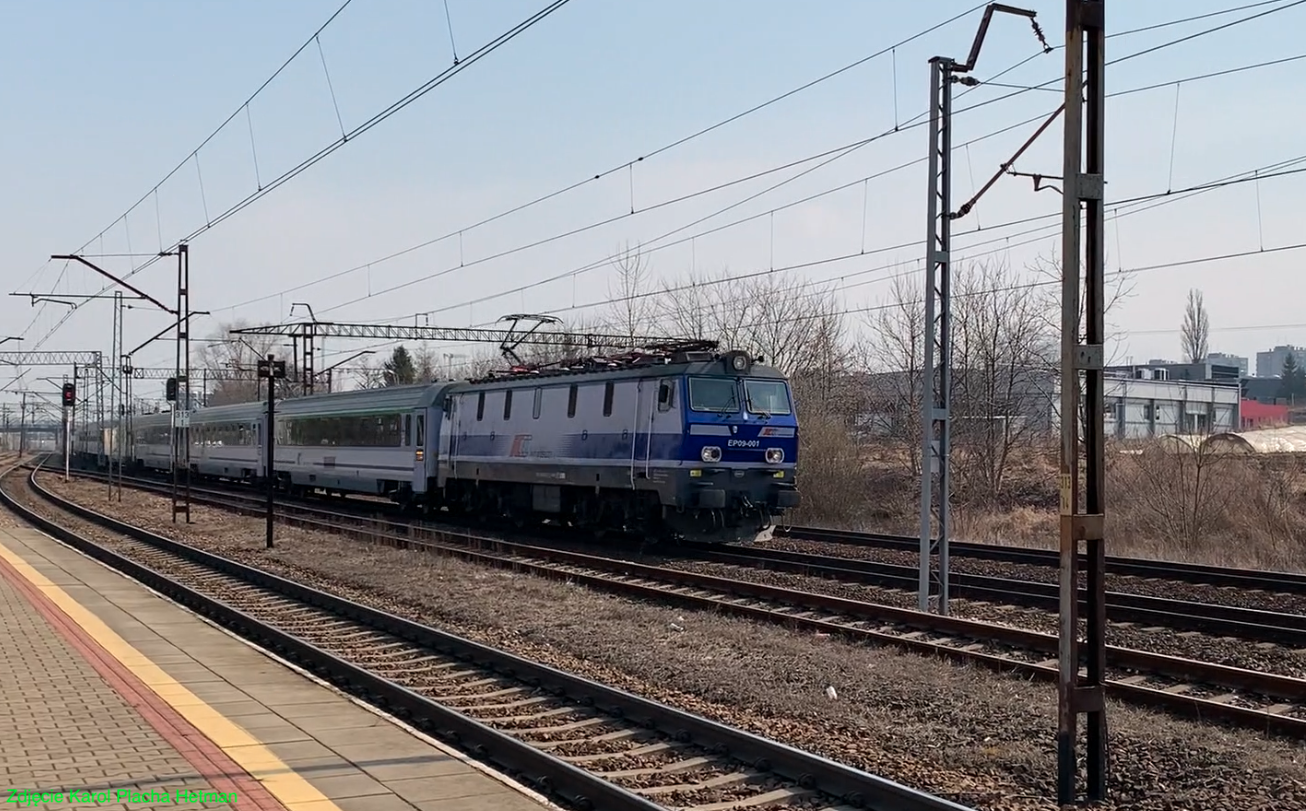Kraków 2024-01-21
Electric Locomotive EP09-001.



The origins of the EP09 electric locomotive.
In the 1960s in Poland, it was a time when air transport was in its infancy and trucks provided local transport. The real lifeblood of the national economy was the railway. Permanent electrification of main railway routes. Good diesel and electric locomotives were produced. The construction of new railway routes Silesia - Warsaw - Tricity and Silesia - Eastern border of Poland was considered (because the Polish economy was dependent on the CCCP economy).
The detailed plans included the construction of railway line No. 4 from Grodzisk Mazowiecki to Zawiercie, i.e. the Central Railway Main Line (CMK). The documentation was created in 1970. Trail No. 4 has been built and is 223.824 km long. The trail has been adapted to a travel speed of 250 km/h. The curves on the trail have a radius of 4,000 m and are larger than those in France on TGV routes (3,800 m). Until now (2024), CPK Północ has not been built.
After martial law, in 1984, the first express passenger trains were sent to CMK. The "Górnik" express ran on the Warsaw - Katowice route, with the EU05 locomotive reaching a speed of 140 km/h. The modernized EP05 locomotive reached a speed of 160 km/h, but it ran erratically and lacked power. Therefore, the trains were driven by two EP05 locomotives. A new electric locomotive had to be designed and built for the trail. The EP23 locomotive program based on the ET22 was abandoned because analyzes showed that it would not meet expectations. When designing a new electric locomotive, there was no risk of program failure, as was the case with the SP47 series diesel locomotives many years earlier.
Already in the period 1977–1978, preparatory and design work on three types of new locomotives was carried out at the Rail Vehicles Research and Development Center in Poznań. The first is the type 104E project, a four-axle Bo'Bo' passenger vehicle with a maximum speed of 140 km/h. The second project is type 204E, six-axle in the Bo'Bo'Bo' arrangement, passenger and cargo, with speeds of 160 and 120 km/h, respectively. The third project is type 205E, a two-unit cargo vehicle in the Bo'Bo'+Bo'Bo' configuration, with a speed of 100 km/h.
Construction of prototypes.
In 1981, documentation was completed for the type 104E locomotive, which was marked EP09 in PKP and popularly called "Dziewiątka", and years later "Epoka". The construction of prototypes and serial locomotives was commissioned to the National Wagon Factory (PaFaWag) in Wrocław. In 1986, two prototypes were built. The second prototype was shown at the Poznań International Fair in June 1987.
During the construction of the first locomotive, it was decided to increase the maximum speed from 140 km/h to 160 km/h. For this purpose, a new traction motor-wheel transmission was developed.
Throughout the 1980s, the EP09 program had enemies, mainly among members of the Polish United Workers' Party and in Moscow. But he also had ardent supporters who, thanks to their determination and strong will, saw the program through to the end, and kudos to them for that. The parameters of the EP09 locomotive brought our railway industry to the level of Western Europe, which is why the program was a threat to the dominance of CCCP. Poland was forced to conduct the program in cooperation within Comecon. It was obliged to use components produced in CCCP, Czechoslovakia and Hungary. These include CCCP engines, which were modernized in Poland. Fortunately, the EP09 program did not fail. Let's remember that if in Moscow they were told "тебе не нужно делать, не надо" (you don't have to do it, don't do it), there wouldn't be a single penny for a new locomotive.
On March 19, 1987, the EP09-001 locomotive was transferred to the Kraków Prokocim locomotive depot, where it was tested on various routes, including mountain ones. Tests have shown that there is more wear on the wheel flanges on mountain trails, which is a typical phenomenon. A wheel flange lubrication system was considered but not implemented. A bigger problem was cracks in the suspension of traction engines. Another problem was the large magnetic field created when driving at maximum speed, which required shielding.
EP09-002 was also transferred to Krakow on October 21, 1987. Then the EP09-002 locomotive was tested on the main route, i.e. on the CMK. The locomotive pulled a train of 11 wagons, including 2 measuring wagons. The cruise control system, i.e. the set speed system - UPZ, which was able to maintain a speed of 160 km/h, was tested. The distances Warsaw - Katowice and Warsaw - Kraków were covered many times.
On May 15, 1988, EP09 locomotives were authorized to operate on the Central Railway Main Line at a speed of 160 km/h. When the new timetable came into force on May 29, 1988, locomotives made their debut in passenger transport. At that time, the schedule was changed once a year, at the turn of May and June, on a Monday. The EP09-001 locomotive pulled the "Krakus" train (Warszawa Centralna - Kraków Główny), replacing the EP05 locomotive. While driving, a speed of 160 km/h was easily achieved. The average travel speed was 106.5 km/h.
A few days later, the second locomotive EP09-002 entered service. The locomotive led the "Górnik" train (Warszawa Centralna - Katowice - Gliwice). Trains were scheduled to run at a speed of 160 km/h.
It was expected that by the end of 1988, the Kraków Prokocim and Warsaw Olszynka Grochowska locomotives would have 3 new EP09 locomotives each, but this was not achieved.
The initial operation of EP09 revealed faults that were systematically removed. There were cracks in the electric motor supports and failures in the electrical installation. Modifications were introduced to the locomotives, which extended the production time of subsequent locomotives. In order not to prolong the commencement of series production, it was decided to use a classic resistance start instead of the planned thyristor start. The air compressors were also replaced because the model chosen was failing too often. The collapse of the bloc of socialist countries in 1989 will also result in the abandonment of some modern solutions. Proven solutions from EU07 were used, which were no longer the latest, but guaranteed fewer problems during operation.
The first two locomotives EP09-001 and EP09-002 were modernized and designated EP09 type 104a. Since 1990, serial locomotives marked EP09 type 104b have been produced. The EP09-003 locomotive hit the roads on November 30, 1990. The EP09-004 locomotive hit the roads on December 5, 1990. The EP09-005 locomotive hit the roads on January 3, 1991. The EP09-006 locomotive hit the roads on January 5, 1991. The last EP09 locomotive was built in 1997, when PaFaWag was taken over by Adtranz. The Adtranz company is a German company that operated in the period 1996 - 2001, and due to poor management, it was sold to the Bombardier concern. 47 EP09 locomotives were built, out of a planned 200 units. It is a common opinion that no two EP09s are identical, even though the external differences are minimal.
From other projects of this program, the 205E prototype was built - a two-unit cargo vehicle (Bo'Bo' + Bo'Bo'), which was not subjected to comprehensive tests and was ultimately created in the classic version, i.e. two solos. Locomotive 204E, six-axle (Bo'Bo'Bo'), was not built.
EP09 design.
The EP09 locomotive has a classic layout. The frame to which the box is attached is supported on trolleys. The locomotive has a driver's cab at both ends. The middle part of the locomotive is the machinery room. The locomotive on the roof has two classic, scissor or half pantographs (current collectors).
The locomotive has two two-axle bogies (Bo'Bo'), which were developed at OBRPS Poznań. The carts were modern designs. Instead of a pivot pin, hangers and springs were used to connect the trolley to the box. The bogies were connected with an inter-bogie coupling, which ensured the locomotive ran smoothly. The first stage of suspension was equipped with coil springs and hydraulic shock absorbers. At the second stage, a flexible connection between the box and the trolleys was introduced, based on Flexicoil springs. Previously, there were hangers that were more rigid and broke. This change took place in 1994, with locomotive EP09-038.
The EP09 locomotive has a double braking system. Pneumatic Oerlikon type and electrodynamic brake (ED), developed by the Warsaw Institute of Electrical Engineering. EP09 is the first locomotive with such a brake. The ED brake converts kinetic energy into electrical energy lost in the starting resistors. The use of the ED brake reduced brake pad wear. The third parking brake is hydraulic, not mechanical.
The locomotive has four LKa740 traction engines, which were developed in Wrocław at the Dolmel plant, based on a Soviet engine. Unlike in EU07, the solution was to transfer the power from the engines to the wheels. The engines are rigidly mounted on bogies. The power is transmitted through two tapered roller bearings to the clutch, then to the hollow shaft and through another clutch to the wheel sets. This allowed for increased reliability of the drive system. It is a completely Polish solution developed by a team led by Eng. Przemysław Hoffman. Most electrical components are made in Poland. Thyristor start was developed, which was not introduced in series locomotives. The locomotive does not have multiple control, so you cannot connect two locomotives together.
There were two designs for the driver's cab. The first one was developed at OBRPS in Poznań. The second cabin was developed by the Wrocław University of Science and Technology. In 1988, the design of the Wrocław University of Science and Technology was selected, which was considered more ergonomic. The cabins are electrically heated. The last 10 units were equipped with air conditioning, which is installed in other locomotives during renovations. There are two windows in the front of the locomotive, the glass of which is glued, multi-layered and electrically heated. EP09 was equipped with cruise control, i.e. the UPZ set speed system, which, however, was omitted. The introduction of UPZ resulted in a change of the type designation to 104Ea. Only the EP09-002 locomotive was equipped with UPZ. The driver's cab is well insulated thermally and acoustically. The floor of the driver's cabin is based on rubber shock absorbers attached to a steel base. Drivers can use an electric stove located in one of the cabins and a washbasin also located in one of them. The tank held 37 liters of water. An absorption refrigerator with a temperature controller is provided for storing food products. It was not decided to install a toilet.
The EP09 locomotive is built in a classic way. Mechanic's cabins were installed at both ends of the box. The central part of the vehicle houses all the locomotive equipment; HV cabinets, LV cabinets, compressors, fans, converters, etc. Many of the installed devices come from the EU07 locomotive. The corridor is placed along one of the walls of the box. There are windows there. The other side of the box has no windows, only large ventilation grates. An interesting feature of the EP09 locomotives is the hatch in the roof of the locomotive. The locomotive uses 3 kV current to heat the attached passenger cars and the locomotive itself.
EP09 basic data:
Weight in service condition 83,500 - 85,900 kg. Total length 16.74 m. Box width 2.974 m. Height is 4.30 m. Design speed 160 km/h. Wheel diameter 1.25 m. LKa-740 engines from Dolmel. The power of one traction engine is 730 kW. Locomotive continuous power 2,920 kW. Gear ratio 73:38. The minimum track curve radius is 120 m.
Operation EP09.
EP09 locomotives were inspected and repaired mainly at the Pafawag or ZNLE Gliwice plants (Zakłady Naprawcze Lokomotyw Elektrycznych). Since 2007, renovations have been carried out only in ZNLE / Newag Gliwice. During repairs, numerous modifications were introduced to EP09 locomotives.
EP09 locomotives have classic scissor pantographs or half-type Stemmann pantographs. There were cases where a locomotive had two different pantographs. The "Bucket" headlights in the locomotives were replaced with new panoramic halogen headlights. Since 2011, newer control panels, GPS and GSM devices and a place for ETCS (European Train Control System), an additional air compressor, air conditioning installation, converter modernization and others have been installed.
After the division of PKP into numerous companies, all EP09 locomotives were transferred to PKP Cargo. In the period 2007–2009, all EP09 were transferred to PKP Intercity.
In December 2007, EP09 locomotives received certificates of approval for operation on tracks in the Czech Republic. Czech locomotives received the same certificate for tracks in Poland (in some DOKPs).
EP09 locomotives will be withdrawn when InterCity concludes a contract for the purchase of at least 40 new electric locomotives. In 2017, InterCity announced a competition for offers for P4 level repairs for all EP09 locomotives. So far, contracts have been concluded for single locomotives. The tender was not resolved and was repeated. In 2020, two companies renovating electric locomotives submitted offers: Olkol and Newag. Currently (May 2021), the contract has not been concluded yet.
Written by Karol Placha Hetman
